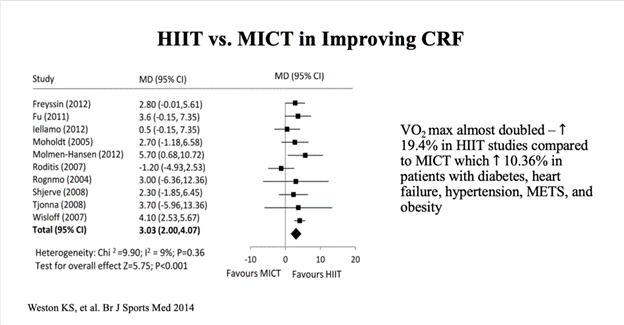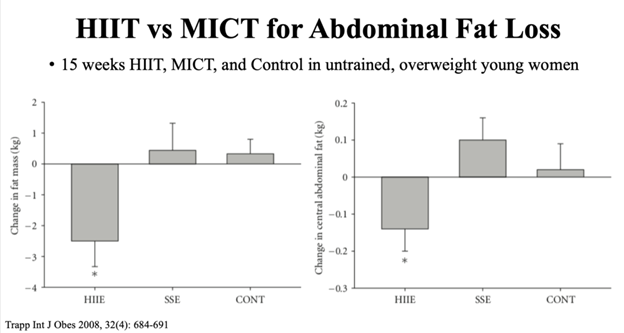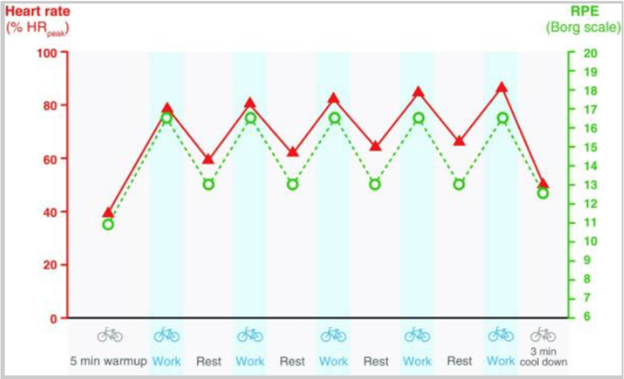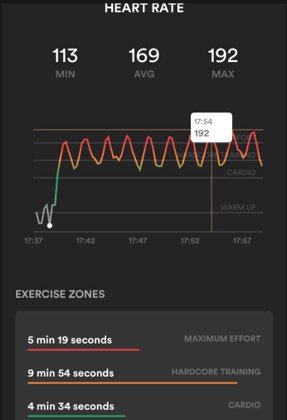Looking to fight chronic disease, lose belly fat, maintain muscle, and live longer? Look no further than High-Intensity Interval Training, also known as HIIT. Scientific consensus indicates that it is far more effective than Moderate- Intensity Continuous Training, also known as MICT or simply as a traditional cardio workout.
What is HIIT?
As explained above, HIIT means high-intensity interval training, a form of intermittent cardio workout where one is working out in the range of high aerobic intensity and has phases of low aerobic intensity in between. There are several types of protocols that one can always perform according to this HIIT session’s goal. The main parameters to adjust are the following:
- Length of the work interval
- Length of rest interval
- The intensity of work interval
- The intensity of rest interval
- Number of sets
- Number of reps
- Art of exercise performance
One can adjust the art of metabolic outcome and has points upon which the daily and weekly training can be periodized.
What are the benefits of HIIT?
People who performed HIIT saw more significant benefits with 40% less time training than MICT groups, they were better able to lose fat (especially intra-abdominal fat, the most dangerous and most highly linked to chronic disease), better-maintained muscle, gained strength, decreased fat storage, increased insulin sensitivity, and the list goes on and on.
A medical study (Weston et al., 2013) demonstrated that cardiorespiratory fitness (CRF) strongly determines morbidity and mortality. In athletes and the general population, it is established that high-intensity interval training is superior to MICT in improving CRF. Multiple studies (Perry et al., 2008; Talanian et al., 2007) also showed significantly higher fat burn after only 2-6 weeks of HIIT training 3 to 6 times per week.

Let’s delve a little further into the fat loss aspect of this type of workout. Everyone hates intra-abdominal fat: Doctors hate it due to the link to chronic disease; regular people hate it because it can be very challenging to get rid of, especially as you age. Weston et al. (2013) showed that HIIT was better for losing intra-abdominal fat and visceral adipose tissue.

Visceral adipose tissue is fat tissue surrounding the organs. It is considered the most dangerous and most highly linked to disease, but fortunately, it’s also the easiest to lose. My take on this is that there may not be any difference in body composition with matched energy expenditures between groups throughout the study. Still, there was likely better body fat reduction long term with HIIT due to higher mitochondrial biogenesis and excess post-exercise oxygen consumption (EPOC).
EPOC is another reason for the effectiveness of this training format which results in high post-exercise energy expenditure that leads to more calories burned during recovery (LaForgia et al., 2006). Essentially, if you train your ass off, your body will burn more calories even after you’re done with your workout. Imagine burning calories while you hit the showers. This is scientifically possible with this training regimen. It also leads to an increase in the size and number of mitochondria, thus leading to more energy being used towards working muscles and a higher force production over time (Hawley & Gibala, 2009).
The last point to touch upon is the improvement of glycolytic activity. Intermittent intensity and energy requirements lead to heightened and lowered glycolytic activity metabolic patterns. What is meant by that? The metabolic rate of converting stored energy in glycogen in your muscles and liver into glucose which is then further metabolized for ATP production. By performing exercise in a high intensity, anaerobic energy supply is increased and, over time, enhanced, which is an adaptation to HIIT (Buchheit and Laursen, 2013).
What does a typical HIIT session look like?

As you can see, this is a 10×1min HIIT session (with a short warmup before) where the intervals consist of the same intensity of about >87% VO2max (maximum rate of oxygen consumption measured during incremental exercise) followed by rest intervals of about 20% VO2max. You could also adjust the intensity by your peak heart rate, exercising at approximately >90% max heart rate, as both are methods for endurance intensity workload determination (Karvoonen & Vuorimaa, 1988).


How do I adjust my HIIT training?
There is no ‘one fits all solution; this always comes down to specific requirements and training goals. Generally speaking, one can say that the longer the intervals, the more it taxes on your glycogen stores, and the more reps/sets you do, the more they demand of you.
One way to start your routine for general CRF and fat metabolism improvement is with a 5-minute warmup, followed by 4×4-min intervals at approximately 85-95% of your peak heart rate and 3 min recovery in between. You can participate in this workout between three and six times per week, and your lifespan-boosting activity only has to last twenty to thirty minutes.
I like to go for 170 beats per minute (bpm) and higher and then allow my heart rate to drop to about 100-110 bpm before the next set. Your numbers don’t necessarily have to be so specific. Get your heart rate up high and down low as long as the interval is.
If you want to get more severe and double down on your aerobic capacity improvement, here is something for the intermediate athletes of you:
A rule of thumb (scientifically proven to be beneficial for VO2max improvement) is a 2:1 work:rest-ratio (Rønnestad et al., 2015, Rønnestad et al., 2020). 30:15sec or 40:20sec work:rest-intervals in a 3×13 or 3×10 setting, respectively, with 3 min breaks between sets, increase your VO2max even more than effort matched longer intervals of 5 min work and 2.5 min rest for four series.
Is there an ‘ideal’ version for a HIIT workout?
That is probably another question that has to be decided individually regarding the desired outcome of your training.
Studies have shown that HIIT in the format of 87-100% VO2max is the most effective method for increasing your overall VO2max (Buchheit & Laursen, 2013a) and, therefore, metabolic fitness. Also, the work:rest-ratio is a factor to consider when planning your HIIT session.
A study by Seiler and Hetlelid (2005) showed that 4 min breaks do not offer a significant increase in restfulness over 2 min breaks. Shorter intervals (<1.5-2 min) do not tax so hard on the metabolic, mainly glycolytic, system. Beyond that, you can implement shorter rest intervals to increase overall intensity.
For speed improvements, such as in running or cycling, one could summarize: longer intervals improve speed endurance maintenance. In comparison, shorter intervals enhance anaerobic glycolysis and speed endurance production.
How do I get started?
Unfamiliar with your peak heart rate or even VO2max? Estimate your peak H.R. with this easy formula: 220 – age = max. BPM. My max is about 193 because I’m 27 years old. Therefore, 85% for me would be 165 bpm. Via [211 – 0.64 x age], you will get a slightly more precise result, adjusted for generally active people. Don’t have a wearable device to conduct measurements? Take your pulse. 25 beats in 10 seconds equal 150 bpm (simple multiplication).
The best way to get your heart rate up is to use as much musculature as possible. Examples include sprints (running or cycling), burpees, and squat jumps. There are also plenty of other examples to choose from. The logic is that the more muscles are used, the greater the cardiovascular demand, and thus your heart rate. No matter how hard you go on isolation exercises, it will be unlikely to get your heart rate where you want it because small muscles don’t require a high demand.
My favorite HIIT exercises are sprints, 100 rep sets of weighted jump rope as fast as possible, and burpees. Here is a picture of my recent HIIT workout. That’s my heart rate data tracked with a BioStrap device. I highly recommend using wearables to track your heart rate for maximum accuracy. The ones manufactured by Biostrap are very reliable and helpful to my workout regimen.
References:
- Buchheit, M., & Laursen, P. B. (2013a). High-intensity interval training, solutions to the programming puzzle: Part I: cardiopulmonary emphasis. Sports medicine (Auckland, N.Z.), 43(5), 313–338. https://doi.org/10.1007/s40279-013-0029-x
- Buchheit, M., & Laursen, P. B. (2013b). High-intensity interval training, solutions to the programming puzzle. Part II: anaerobic energy, neuromuscular load, and practical applications. Sports medicine (Auckland, N.Z.), 43(10), 927–954.https://doi.org/10.1007/s40279-013-0066-5
- Hawley, J. A., & Gibala, M. J. (2009, June 26). Exercise intensity and insulin sensitivity: how low can you go? Diabetologia. https://link.springer.com/article/10.1007/s00125-009-1425-5?error=cookies_not_supported& code=7b9628ca-d570-4c91-816d-4cb4afd415b2
- Karvonen, J., & Vuorimaa, T. (1988). Heart rate and exercise intensity during sports activities. Practical application. Sports medicine (Auckland, N.Z.), 5(5), 303–311. https://doi.org/10.2165/00007256-198805050-00002
- LaForgia, J. (2006). Effects of exercise intensity and duration on the excess post-exercise oxygen consumption. PubMed. https://pubmed.ncbi.nlm.nih.gov/17101527/
- Perry, C. G. R. (2008). High-intensity aerobic interval training increases human skeletal muscle fat and carbohydrate metabolic capacities. PubMed. https://pubmed.ncbi.nlm.nih.gov/19088769/
- Rønnestad, B. R., Hansen, J., Vegge, G., Tønnessen, E., & Slettaløkken, G. (2015). Short intervals induce superior training adaptations than long intervals in cyclists – an effort-matched approach. Scandinavian journal of medicine & science in sports, 25(2), 143–151. https://doi.org/10.1111/sms.12165
- Rønnestad, B. R., Hansen, J., Nygaard, H., & Lundby, C. (2020). Superior performance improvements in elite cyclists following short-interval vs. effort-matched long-interval training. Scandinavian journal of medicine & science in sports, 30(5), 849–857. https://doi.org/10.1111/sms.13627
- Seiler, S., & Hetlelid, K. J. (2005). The impact of rest duration on work intensity and RPE during interval training. Medicine and science in sports and exercise, 37(9), 1601–1607.https://doi.org/10.1249/01.mss.0000177560.18014.d8
- Talanian, J. L. (2007). Two weeks of high-intensity aerobic interval training increases the capacity for fat oxidation during exercise in women. PubMed. https://pubmed.ncbi.nlm.nih.gov/17170203/
- Weston, K. S. (2013). High-intensity interval training in patients with lifestyle-induced cardiometabolic disease: a systematic review and meta-analysis. PubMed. https://pubmed.ncbi.nlm.nih.gov/24144531/









This is my first time pay a quick visit at here and i am really happy to read everthing at one place